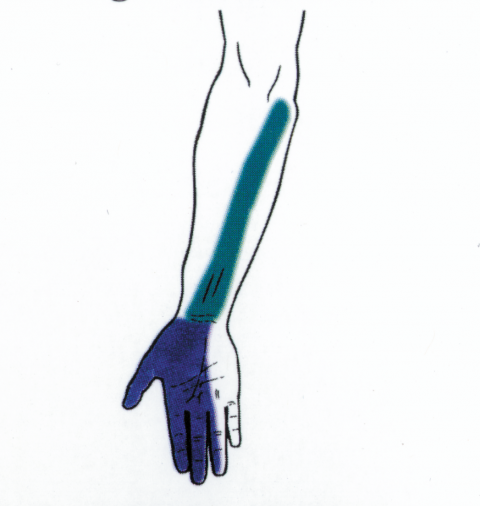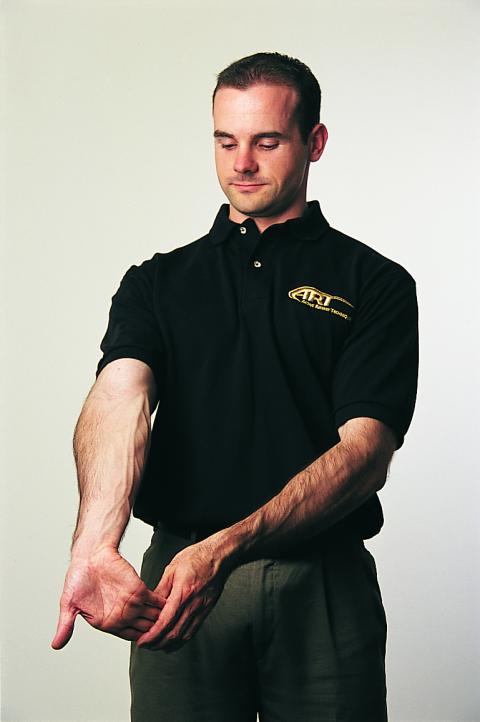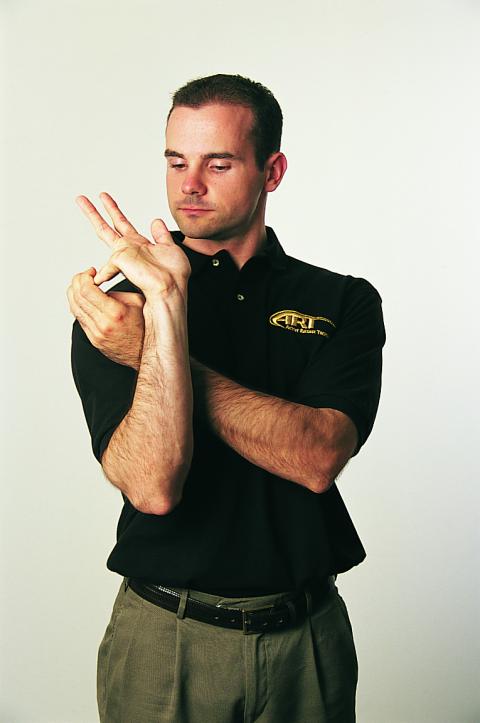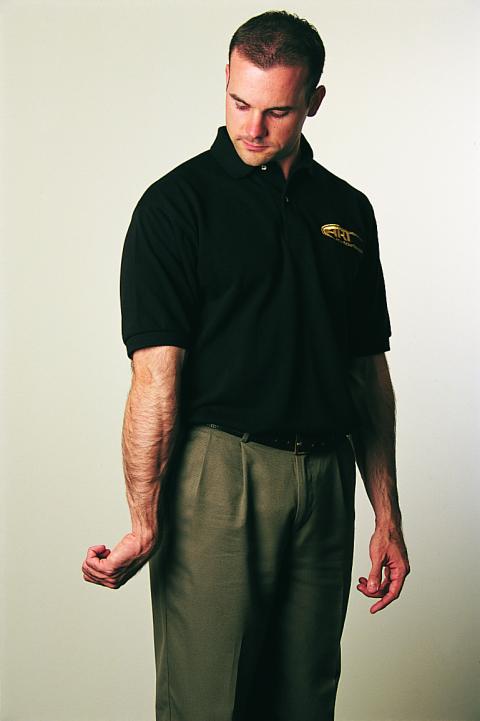A New Understanding of Overuse Injuries
The days of overprescribed rest, ice, and medication are over.

Pain from carpal tunnel syndrome affects the areas surrounding the median nerve in the forearm, thumb, and first two and a half fingers only.
Does the following situation sound familiar? You put in long hours on your instrument practicing for an important gig or audition only to find that the nagging, on-and-off pain you’re experiencing occurs more frequently. Reluctant to cut back your practice time or cancel the upcoming engagement, you start icing the affected area, stretching, and ingesting more medication than your liver cares to process. Despite taking all the measures that you have heard will help to ease the pain, your discomfort increases.
We now know that the treatment methods described above will not rid you of the problem. It has long been assumed that inflammation is responsible for the pain that musicians frequently suffer from and that it is associated with repetitive motions and sustained postures. It turns out, however, that this assumption is wrong. Those in the medical profession have made new discoveries that are revolutionizing the treatment of overuse injuries.
Not Tendinitis
Tendons are structures that connect muscles to bone and therefore transmit muscular force to produce movement. When tendons become injured, inflamed, and painful, the condition is called tendinitis. We all know someone who has been told they are suffering from rotator cuff tendinitis or tennis elbow (a.k.a. lateral epicondylitis). This diagnosis is correct only for a small number of cases. In order for the problem to be diagnosed as tendinitis, inflammation must be present. Inflammation is the body’s response to injury. When an injury occurs, the body sends various cells to the area to destroy the injured tissue and set the stage for healing. Standard treatments such as ice, rest, and anti-inflammatory medication are designed to combat excessive inflammation. But, inflammation is rarely present in cases of chronic tendon pain. Research by two prominent orthopedic surgeons led to new understanding of the cause of overuse injuries.
Tendinosis versus Tendinitis
In 1979, surgeons Robert P. Nirschl and Frank A. Pettrone removed sections of injured elbow tendons from patients and examined them under a microscope. Remarkably, they found no inflammation. Instead, they found that the tendons were degenerated, swollen, grayish rather than white, and soft. Tendinosis is the correct name for this condition, which has for years been mislabeled as tendinitis.
What causes the degeneration accompanying tendinosis? The repeated or sustained muscular contraction associated with mastering virtually any musical instrument causes a decrease in blood flow to the working muscles and tendons. This lack of blood flow then causes an accumulation of waste products. These waste products are very similar to those produced when a muscle is torn. The waste products in turn attract the cells that produce scar tissue. This is helpful if indeed you have torn a muscle, but in the case of overuse injuries, the body is signaled to repair muscles that are not really damaged. The body is thus fooled into thinking there has been an injury and tries to repair it. The result is an accumulation of scar tissue in otherwise healthy muscles and tendons. The scar tissue increases stress on the tendons and they begin to degenerate.
Visualize pouring glue on a healthy tendon; this is the effect that scar tissue creates. It prevents normal stretching and limits muscle contraction. This can cause a decreased range of motion, pain with use, decreased strength, and early fatigue. In fact, pain is often the last symptom to show up. Overuse injuries usually start with one muscle or tendon developing scar tissue. The involved muscle is then weakened, requiring neighboring muscles to become overworked. With continued use and the passage of time, the neighboring muscles begin to develop scar tissue. This cycle of increasing stress, buildup of scar tissue, and degeneration continues until the body can no longer compensate. At this point, the system has broken down and chronic pain sets in.
Nerve Entrapment

WRIST PRONATORS 1. Stretch fingers back, 2. Straighten arm. 3. Gently pull fingers in toward center of body.

WRIST FLEXORS 1. Bend elbow and extend wrist (as if holding a tray), 2. Reach around and stretch last two fingers downward.

WRIST EXTENSORS 1. Let arm hang by side with wrist flexed. 2. Rotate hand outward. 3. Make a loose fist.
Another unfortunate problem that can occur with scar tissue accumulation is nerve entrapment. In addition to muscle and tendon pain, those suffering from overuse injuries can experience symptoms of numbness, tingling, deep aching, or burning. These symptoms are caused by increased tension on nerves. In size and feel, nerves resemble spaghetti. Their function is to transmit information from the environment to the brain and spinal cord. There are many places in the body where nerves travel through and adjacent to muscles and tendons. If a muscle develops scar tissue in close proximity to a nerve, the two can become fused together and cause problems. In order for nerves to function properly, they must be able to glide past the nearby muscles and tendons. The ulnar nerve, for example, lies in a groove behind the elbow (the area commonly referred to as the “funny bone”) and must slide several centimeters when the elbow is bent.
When a nerve becomes adhered to the surrounding muscles, it cannot glide and so it stretches instead. This stretching injures the nerve and usually causes symptoms such as tingling down the forearm and into the pinky finger. There are approximately 30 locations in the arm, shoulder, and neck where nerves can become trapped. Nerve entrapment is the culprit in many cases of carpal tunnel syndrome, and generally not only the carpal tunnel is involved.
It is important to have an accurate understanding of carpal tunnel syndrome. It occurs when the median nerve, one of the three major nerves in the arm, is compressed in the wrist. Symptoms of carpal tunnel syndrome include numbness, tingling, and aching or burning into the thumb and first two and a half fingers. These symptoms can be accompanied by tightness and pain in the front of the forearm (see fig. 1). If you experience symptoms in the pinky or in the outside of the ring finger, you don’t only have carpal tunnel syndrome, other nerves are involved. Also, if the pain and symptoms are predominately in the forearm with the hand experiencing mild symptoms or none at all, it is likely that you are experiencing more than just carpal tunnel syndrome. Too often, health-care providers call any pain in the hand or forearm carpal tunnel syndrome. This is a crucial mistake because effective treatment is predicated upon an accurate diagnosis.
Tendinosis and Its Treatment
Creating scar tissue is the only mechanism that muscles have for healing. The development of scar tissue, therefore, is the body’s fairly universal response to stress and injury. If you are experiencing pain from overuse, there is a high probability that scar tissue and degeneration are occurring. Scar tissue does not go away by itself. If you take time off from playing and feel better but find that pain returns to the affected area once you start to play again, it is likely that scar tissue is present. In contrast, an inflammatory problem resolves with rest and does not return.
With the understanding that overuse injuries are most often degenerative-scar-tissue problems rather than inflammatory problems, treatment strategies must change accordingly. Over- prescribed rest, ice, anti-inflammatory medication, and electrical stimulation are no longer the treatments of choice.
Active Release Techniques (ART) are the best treatment for the reduction of scar tissue and reversing degeneration. The procedure is as revolutionary as the realization that overuse injuries are not the result of inflammation. As an article in the June 1999 issue of the Journal of Occupational Rehabilitation reported: “Results [with ART] demonstrated a 71 percent success rate, which, when compared to similar studies in the literature, was superior.”1 Doctors trained in ART are able to locate scar tissue by touch. The characteristics they look for include increased tension, abnormal texture, and restricted movement. The treatment involves soft-tissue manipulation done exclusively with a doctor’s hands. Therefore there are no unwanted side effects from medication or surgical complications.
The process is as follows. First, the doctor identifies the scarred area by palpating or feeling it. Second, the muscle, tendon, ligament, or nerve is shortened by moving the body part. Third, the doctor places a contact (the fingers or a thumb) on the scar, creating tension. Fourth, the patient moves the body part back to its original position to lengthen the structure. This generates tension that breaks down scar tissue and restores normal movement, tension, texture, and function to the tissues, which reduces pain and improves performance. Most visits generally take only 10 to 15 minutes, and the problems are frequently resolved with 8 to 10 treatments.
Prevention
Holding postures for hours a day and repeating a motion thousands of times can easily lead to overuse injuries. Preventing these injuries can be challenging. There are a few things to be aware of, however, that will greatly reduce your chances of encountering this problem. They include the following:
•Proper technique. Perform all motions
and positions in a manner that produces
the least amount of stress on the muscles
and tendons. Listen carefully to teachers
and observe those with good technique to
learn proper form and grip on your
instrument.
•Performance load. You need to be aware
of just how much you are playing. The
more you play the more likely you are to
develop a problem. If you find yourself
practicing three hours a day and perform-
ing 12 hours on weekends, you may be
doing too much. Another factor that can
speed recovery between playing sessions is
getting plenty of rest, that is, quality sleep.
•Stretch. Stretching keeps the muscles
and nerves sliding and moving the way they
are designed to and improves blood cir-
culation. Regular stretching slows or
prevents the production of scar tissue and
keeps nerves and muscles from adhering
together. The best way to stretch is to bring
the motion to the point where you begin to
feel tension. Maintain this position for 10 to
15 seconds and repeat the exercise every
hour (see sidebar). Doing these exercises
hourly is more beneficial than stretching for
10 minutes once a day.
•Nutrition. Proper nutrition decreases
the amount of chemical waste products that
are produced during muscle contraction
and helps the body flush out waste faster.
Make sure to get enough quality protein
and essential fats. Fish and nuts are excel-
lent sources of these proteins and fats. You
should absolutely avoid sugar and satur-
ated fats. Unfortunately, one or both of
these components are found in almost all
good-tasting foods. In addition, try to avoid
fatty meats, potato chips, bacon, and pizza.
Proper nutrition can be a critical element in
preventing or helping to resolve overuse
injuries.
Conclusion
This new information offers effective treatment that will lead to better playing. With the help of ART, injuries that were once thought to be career terminators can be treated successfully, prolonging careers and musical enjoyment.
Footnote:
- Berit Schlottz-Christensen, Vert Mooney, Shadi Azad, Dan Selstad, Jennifer Gulick, and Mark Bracker, “The Role of Active Release Manual Therapy for Upper Extremity Overuse Syndromes: A Preliminary Report,” in Journal of Occupational Rehabilitation, Vol. 9, no. 3, 1999, Bethesda, Maryland.
Author credit:
Dr. William F. Brady operates Run Better, a cutting-edge health-care facility in Boston specializing in overuse injuries. Contact Dr. Brady at (617) 367-3110. To find an ART provider in your area, visit www.run-better.com, click on “links,” and then click on the ART logo.
The days of overprescribed rest, ice, and medication are over.
Does the following situation sound familiar? You put in long hours on your instrument practicing for an important gig or audition only to find that the nagging, on-and-off pain you’re experiencing occurs more frequently. Reluctant to cut back your practice time or cancel the upcoming engagement, you start icing the affected area, stretching, and ingesting more medication than your liver cares to process. Despite taking all the measures that you have heard will help to ease the pain, your discomfort increases.
We now know that the treatment methods described above will not rid you of the problem. It has long been assumed that inflammation is responsible for the pain that musicians frequently suffer from and that it is associated with repetitive motions and sustained postures. It turns out, however, that this assumption is wrong. Those in the medical profession have made new discoveries that are revolutionizing the treatment of overuse injuries.
Not Tendinitis
Tendons are structures that connect muscles to bone and therefore transmit muscular force to produce movement. When tendons become injured, inflamed, and painful, the condition is called tendinitis. We all know someone who has been told they are suffering from rotator cuff tendinitis or tennis elbow (a.k.a. lateral epicondylitis). This diagnosis is correct only for a small number of cases. In order for the problem to be diagnosed as tendinitis, inflammation must be present. Inflammation is the body’s response to injury. When an injury occurs, the body sends various cells to the area to destroy the injured tissue and set the stage for healing. Standard treatments such as ice, rest, and anti-inflammatory medication are designed to combat excessive inflammation. But, inflammation is rarely present in cases of chronic tendon pain. Research by two prominent orthopedic surgeons led to new understanding of the cause of overuse injuries.
Tendinosis versus Tendinitis
In 1979, surgeons Robert P. Nirschl and Frank A. Pettrone removed sections of injured elbow tendons from patients and examined them under a microscope. Remarkably, they found no inflammation. Instead, they found that the tendons were degenerated, swollen, grayish rather than white, and soft. Tendinosis is the correct name for this condition, which has for years been mislabeled as tendinitis.
What causes the degeneration accompanying tendinosis? The repeated or sustained muscular contraction associated with mastering virtually any musical instrument causes a decrease in blood flow to the working muscles and tendons. This lack of blood flow then causes an accumulation of waste products. These waste products are very similar to those produced when a muscle is torn. The waste products in turn attract the cells that produce scar tissue. This is helpful if indeed you have torn a muscle, but in the case of overuse injuries, the body is signaled to repair muscles that are not really damaged. The body is thus fooled into thinking there has been an injury and tries to repair it. The result is an accumulation of scar tissue in otherwise healthy muscles and tendons. The scar tissue increases stress on the tendons and they begin to degenerate.
Visualize pouring glue on a healthy tendon; this is the effect that scar tissue creates. It prevents normal stretching and limits muscle contraction. This can cause a decreased range of motion, pain with use, decreased strength, and early fatigue. In fact, pain is often the last symptom to show up. Overuse injuries usually start with one muscle or tendon developing scar tissue. The involved muscle is then weakened, requiring neighboring muscles to become overworked. With continued use and the passage of time, the neighboring muscles begin to develop scar tissue. This cycle of increasing stress, buildup of scar tissue, and degeneration continues until the body can no longer compensate. At this point, the system has broken down and chronic pain sets in.
Nerve Entrapment
Another unfortunate problem that can occur with scar tissue accumulation is nerve entrapment. In addition to muscle and tendon pain, those suffering from overuse injuries can experience symptoms of numbness, tingling, deep aching, or burning. These symptoms are caused by increased tension on nerves. In size and feel, nerves resemble spaghetti. Their function is to transmit information from the environment to the brain and spinal cord. There are many places in the body where nerves travel through and adjacent to muscles and tendons. If a muscle develops scar tissue in close proximity to a nerve, the two can become fused together and cause problems. In order for nerves to function properly, they must be able to glide past the nearby muscles and tendons. The ulnar nerve, for example, lies in a groove behind the elbow (the area commonly referred to as the “funny bone”) and must slide several centimeters when the elbow is bent.
When a nerve becomes adhered to the surrounding muscles, it cannot glide and so it stretches instead. This stretching injures the nerve and usually causes symptoms such as tingling down the forearm and into the pinky finger. There are approximately 30 locations in the arm, shoulder, and neck where nerves can become trapped. Nerve entrapment is the culprit in many cases of carpal tunnel syndrome, and generally not only the carpal tunnel is involved.
It is important to have an accurate understanding of carpal tunnel syndrome. It occurs when the median nerve, one of the three major nerves in the arm, is compressed in the wrist. Symptoms of carpal tunnel syndrome include numbness, tingling, and aching or burning into the thumb and first two and a half fingers. These symptoms can be accompanied by tightness and pain in the front of the forearm (see fig. 1). If you experience symptoms in the pinky or in the outside of the ring finger, you don’t only have carpal tunnel syndrome, other nerves are involved. Also, if the pain and symptoms are predominately in the forearm with the hand experiencing mild symptoms or none at all, it is likely that you are experiencing more than just carpal tunnel syndrome. Too often, health-care providers call any pain in the hand or forearm carpal tunnel syndrome. This is a crucial mistake because effective treatment is predicated upon an accurate diagnosis.
Tendinosis and Its Treatment
Creating scar tissue is the only mechanism that muscles have for healing. The development of scar tissue, therefore, is the body’s fairly universal response to stress and injury. If you are experiencing pain from overuse, there is a high probability that scar tissue and degeneration are occurring. Scar tissue does not go away by itself. If you take time off from playing and feel better but find that pain returns to the affected area once you start to play again, it is likely that scar tissue is present. In contrast, an inflammatory problem resolves with rest and does not return.
With the understanding that overuse injuries are most often degenerative-scar-tissue problems rather than inflammatory problems, treatment strategies must change accordingly. Over- prescribed rest, ice, anti-inflammatory medication, and electrical stimulation are no longer the treatments of choice.
Active Release Techniques (ART) are the best treatment for the reduction of scar tissue and reversing degeneration. The procedure is as revolutionary as the realization that overuse injuries are not the result of inflammation. As an article in the June 1999 issue of the Journal of Occupational Rehabilitation reported: “Results [with ART] demonstrated a 71 percent success rate, which, when compared to similar studies in the literature, was superior.”1 Doctors trained in ART are able to locate scar tissue by touch. The characteristics they look for include increased tension, abnormal texture, and restricted movement. The treatment involves soft-tissue manipulation done exclusively with a doctor’s hands. Therefore there are no unwanted side effects from medication or surgical complications.
The process is as follows. First, the doctor identifies the scarred area by palpating or feeling it. Second, the muscle, tendon, ligament, or nerve is shortened by moving the body part. Third, the doctor places a contact (the fingers or a thumb) on the scar, creating tension. Fourth, the patient moves the body part back to its original position to lengthen the structure. This generates tension that breaks down scar tissue and restores normal movement, tension, texture, and function to the tissues, which reduces pain and improves performance. Most visits generally take only 10 to 15 minutes, and the problems are frequently resolved with 8 to 10 treatments.
Prevention
Holding postures for hours a day and repeating a motion thousands of times can easily lead to overuse injuries. Preventing these injuries can be challenging. There are a few things to be aware of, however, that will greatly reduce your chances of encountering this problem. They include the following:
•Proper technique. Perform all motions
and positions in a manner that produces
the least amount of stress on the muscles
and tendons. Listen carefully to teachers
and observe those with good technique to
learn proper form and grip on your
instrument.
•Performance load. You need to be aware
of just how much you are playing. The
more you play the more likely you are to
develop a problem. If you find yourself
practicing three hours a day and perform-
ing 12 hours on weekends, you may be
doing too much. Another factor that can
speed recovery between playing sessions is
getting plenty of rest, that is, quality sleep.
•Stretch. Stretching keeps the muscles
and nerves sliding and moving the way they
are designed to and improves blood cir-
culation. Regular stretching slows or
prevents the production of scar tissue and
keeps nerves and muscles from adhering
together. The best way to stretch is to bring
the motion to the point where you begin to
feel tension. Maintain this position for 10 to
15 seconds and repeat the exercise every
hour (see sidebar). Doing these exercises
hourly is more beneficial than stretching for
10 minutes once a day.
•Nutrition. Proper nutrition decreases
the amount of chemical waste products that
are produced during muscle contraction
and helps the body flush out waste faster.
Make sure to get enough quality protein
and essential fats. Fish and nuts are excel-
lent sources of these proteins and fats. You
should absolutely avoid sugar and satur-
ated fats. Unfortunately, one or both of
these components are found in almost all
good-tasting foods. In addition, try to avoid
fatty meats, potato chips, bacon, and pizza.
Proper nutrition can be a critical element in
preventing or helping to resolve overuse
injuries.
Conclusion
This new information offers effective treatment that will lead to better playing. With the help of ART, injuries that were once thought to be career terminators can be treated successfully, prolonging careers and musical enjoyment.
Author credit:
Dr. William F. Brady operates Run Better, a cutting-edge health-care facility in Boston specializing in overuse injuries. Contact Dr. Brady at (617) 367-3110. To find an ART provider in your area, visit www.run-better.com, click on “links,” and then click on the ART logo.



